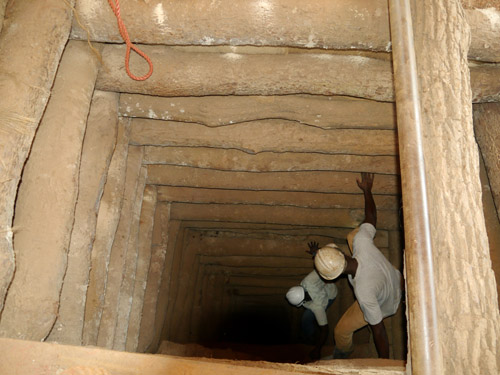Women small-scale gold miners sorting through rock ore in Tanzania.
In early May, I visited small-scale gold miners in Tanzania who were seeking to obtain fair trade certification.
On site, I met with colleagues in from England and Fair Trade Africa, who have been working hard over the past two years in order to build an understanding of fairtrade* standards and principals with the miners on site. The purpose of the visit was also to bring jewelers and miners together to discuss what was needed to bring fairtrade African gold to market.
As the North American commercial liaison for Fairtrade Gold, I was invited to Africa in May 2014, to visit gold mines in Tanzania and Kenya that were aiming to reach certification. I had been working on the Fairtrade issues with my own company, Reflective Images Jewelry, for nearly ten years.
From Resource Curse to Economic Development Initiative
There are about 15 million artisan, small-scale gold miners worldwide, a quarter of whom are children and women. These miners comprise nearly 90% of the labor force in the mining of gold. They supply anywhere from 15 to 25 percent of the global gold supply, mainly through a black market. These figures are estimates because the miners almost always work illegally and without regulation within their countries.
For decades many have tried to devise a way to transform the small-scale mining activities into a sustainable economic development initiative. But the challenges have been daunting. Governments prefer dealing with large multi-national mining companies, which can be monitored and taxed. Yet they export all but a minute value of the mineral out of the country providing few jobs.
Fairtrade gold offers the best hope for helping the small-scale gold mining sector. It transforms small-scale gold mining from a resource curse to an economic development initiative. Fairtade gold from South America was introduced in 2011 and now Fair Trade International is expanding into Africa.
How Fairtrade Gold Works
The fairtrade gold model works with poor, small-scale miners; an operation of 40 to 60 people might mine between three quarters of a kilo and a kilo of gold a month. The ore is then crushed into fine powder with machinery.
Then the gold needs to be concentrated in the crushings, which is done either by hand or through sluices in containment ponds. Mercury is then mixed with dirt, gold and water creating an amalgamate, a solid compound of mercury and gold, which could be between 70 percent and 90 percent pure gold.
The Question of Mercury
Worldwide, small-scale gold mining uses 1,400 metric tons of mercury annually. I have spoken with environmental leaders in North America who have some objection to fairtrade gold because of its use of mercury.
Ultimately, fair trade’s goal is to eliminate mercury use entirely. Operations that do not use mercury will even receive a significant premium for their “eco” gold. Yet we have to set obtainable goals that are realistic. The miners do not have the money to invest in new equipment that would eliminate mercury.
In the meantime, instead of using frying pans previously used to cook plantains and are now used to cook the mercury out of the gold, a retort is used to safely prevent the mercury from escaping into the environment. The mercury can then be reused.
 Small scale miners work in holes reinforced by lumber and haul up the ore filled dirt by hand.
Small scale miners work in holes reinforced by lumber and haul up the ore filled dirt by hand.
Sitting On a Gold Mine But Stuck in Poverty
These days, a kilo of gold might have a value between $40,000 and $45,000. But the miners rely on middlemen who buy gold up to 30 percent under its real value. Also, because refining methods are not totally efficient, miners leave another 25 percent of their gold in the rock tailings.
They make between $100 and $300 a month and often struggle with the basics, like feeding their families. They are sitting on a gold mine, working incredibly hard and are still stuck in a poverty cycle.
Fairtrade Gold: Development & Empowerment
When fair trade gold standards are in place, gold is purchased initially at 95 percent and eventually at 98 percent of the international spot price. Additionally, a $2,000 per kilo premium is paid back to the community, which can be used as the miners choose. With the premium and additional revenue, better equipment can be purchased which can then lead to an increase of 20 percent more gold from the ore.
With auditable fair trade principles and standards that support empowered producers and ethical international business people, small-scale gold mining can become an economic driver that alleviates poverty and preserves the environment. Money stays in their local economy. And, more radically, the miners have control of the full economic resources garnered from their own land.
Building Greater Community
The miners we met with were leaders, eager to share what they had learned. Slowly, over the next five to ten years, with the support of the North American consumer market, I am certain we will see a profound and positive shift in the zones where these pilot projects are taking place.
But our trip was morethan just that. It was also about building greater community around common values of ecologically responsible mining as well as economic and social justice. To listen to the miner’s stories of how they struggled and to see how much they had achieved was incredibly moving.
Fairtrade gold will be formally introduced in the North American market this Fall. When jewelers have it, they can point to the hole from which it was actually dug and say that this wedding ring is profoundly helping artisanal miners live much happier, healthier lives.
As for the customer, what could be better than wearing a wedding ring that in its very sourcing, represents a more beautiful world?
A variation of this article was first published in CSR wire